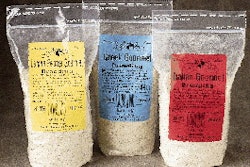Molded pulp producers and their suppliers met in Chicago in December for a reality check. Some 50 representatives of the industry met at the first seminar sponsored by the Molded Pulp Environmental Packaging Assn. (Mequon, WI), including several visitors from Europe and as far away as Australia. After technical papers from consultant Roger Baker and Don Curry of Merrill Eng. (Portland, ME), Dr. Jorge Marcondes of San Jose State University presented a paper on new testing strategies for predicting the performance of molded pulp parts. In describing his school's research, Dr. Marcondes introduced two new techniques for testing parts: perimeter loading and end-cap loading in place of static loading. These tests can give a far more comprehensive look at the pluses and minuses of molded pulp, according to Dr. Marcondes. The highlight was a frank discussion of the pluses and minuses of the material by three customers: Susan Paige, senior packaging engineer for General Motors, Grand Blanc, MI; Dennis Traynor, packaging engineer at Lexmark, Lexington, KY; and Leslie Lindsay, senior packaging engineer for Bose Corp., Framingham, MA. Lindsay's paper reflected her work on projects for Apple Computer, Cupertino, CA, where she worked until an Apple "downsizing" last September. She and Paige are both MPEPA advisory board members. Strong results at Apple Lindsay then described several molded pulp packaging parts that she helped design for Apple Computer. She did qualify her remarks, explaining that some of the projects were as much as five years old, and that just one molded pulp tray she developed remained in use at Apple. While she was looking to use molded pulp for accessory kits for Apple portable Powerbook computers, she first began with a simpler pack for a computer battery. This package proved so successful that versions of it were used for more than 15 products. The accessory kit was far more challenging because it involved providing containment for many parts of different and odd shapes. The resulting molded pulp tray replaced what she called a "corragami" corrugated insert that was assembled with 17 different folds. This labor-intensive insert produced a "treasure hunt" package, she said. Few items could be seen until the insert was unraveled. The pulp tray not only held all of the various accessory parts, but it was so strong that Lindsay realized Apple no longer needed the outer corrugated mailing box. So the tray was wrapped in shrink film. The result of the new tray pack was a savings of 10 sq' of corrugated and a 0.8-lb reduction in weight that reduced shipping costs. The new package also reduced the amount of material for disposal by 30%. Even more impressive, the new package saved $1.02 per unit in packaging costs, and savings were greater still at Apple's European plant. One major contributing factor was the new pack cost 21¢ in labor to pack, one-third the cost of loading the corrugated pack. All the while, Lindsay says, "We got a much better presentation of the accessories to the customer, excellent protection and it was easy to unpack." Just the first step Later, Apple identified that nearly one-third of the packaging cost was represented by the shrink wrap, primarily because of labor. It was eventually eliminated as a manufacturing bottleneck when the company added another corrugated box. The tray was designed to hold all common accessories and the box was used for what were called "local" items, power cords, manuals and the like, that had to be customized for the various markets where the computers were sold. In spite of all these successes at Apple, Lindsay also enumerated a shopping list of improvements on which she felt molded pulp producers should work. Leading the list was more research into cushioning properties to eliminate guesswork. Easier, faster less expensive sampling methods was next on her list. Many manufacturers, she said, need worldwide availability of molded pulp packaging parts, and uniformly transferable part tooling. This, she says, is currently stymied by producers with unique production equipment and differing "recipes" for the paper fiber. Inroads at GM Susan Paige of General Motors' Service Parts Organization explained that her company has developed some 50 molded pulp packaging specifications over the last eight years. These packs are used for over 350 service part numbers, and range from parts as small as dunnage peanuts to large parts that hold automotive bumpers. The motivation for moving into molded pulp, she says, stemmed from several advantages the material provides: environment-friendly, good blocking and bracing properties, good protection from abrasion, easy to use, competitive cost, and satisfaction by this division's customers, its auto and truck dealers. Paige described several specific applications for molded pulp, including a vulnerable louvered grille for a Chevy Lumina that had to be contained between top and bottom pieces of molded pulp to reduce damage. Her group had identified four primary areas of parts where molded pulp worked well: sheet metal parts (like doors), ferrous parts (like brakes and anti-lock brake modules), front-end panels and radiator grilles. When asked later why pulp wasn't being considered for other parts, she explained the frustration of packaging both current parts and continuing to pack replacement parts for much earlier models. "When a category has so many different part numbers, it's a lot easier to continue to develop packs" that are similar to those that we've been using for years, she pointed out. At the end of the session, Hub Ranger, technical director of MPEPA, reported that the group was planning another seminar for mid-1998.






















